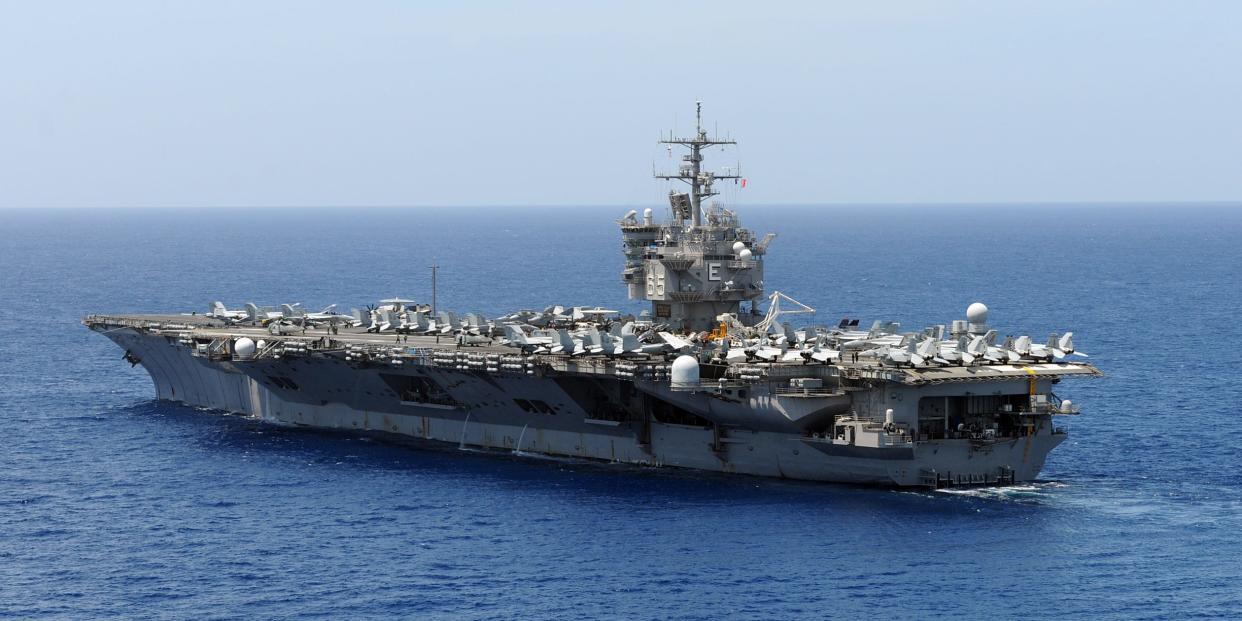The US Navy is looking at scrapping the 'Big E,' the first nuclear-powered aircraft carrier, at a private shipyard

The US Navy is thinking about how best to scrap its first nuclear-powered aircraft carrier, USS Enterprise.
It is looking at sending it to a private shipyard given existing maintenance demands and challenges, a new report shows.
Washington state's Puget Sound Naval Shipyard has historically handled disposing of nuclear-powered naval assets.
The US Navy is considering scrapping the former USS Enterprise, the first nuclear-powered carrier, somewhere other than the sea service's public Puget Sound Naval Shipyard, which has traditionally handled nuclear warship disposal, given the existing fleet maintenance demands.
A newly released draft environmental impact report from the Department of the Navy and Naval Reactors says that the "Big E," which was active in conflicts from the Cold War through the Global War on Terror, should be dismantled and disposed at a commercial shipyard. It did not, however, say where this could occur, though some conventional carriers have been scrapped in Texas.
The report said the Navy wants to "reduce" its inactive ship inventory, axe the costs of maintaining the ship, properly get rid of radiological and hazardous waste, and still meet the service's operational needs.
Puget is already handling maintenance for other operational Navy vessels, and storage of the warship at another public yard is costing the service millions of dollars.
Washington state's Puget Sound Naval Shipyard and Intermediate Maintenance Facility (PSNS & IMF) has historically managed the disposal of nuclear-powered ships, but a Naval Sea Systems Command spokesperson previously told Insider that other work could delay the process for years.
The Bremerton shipyard might not be able to even start work on scrapping the ex-Enterprise until sometime between 2030 and 2040, according to The Kitsap Sun, which first reported the plans.
In its new draft report, the Navy said a commercial shipyard could finish the dismantlement process sooner and at less cost.
"As a result of growing workload due to a higher fleet operational tempo and capacity shortages across all of the Navy public shipyards, PSNS & IMF is challenged to execute their current and projected workload with existing and planned facilities," the new Navy report said.
"Leveraging options to perform ex-Enterprise disposal at commercial facilities is advantageous to the Navy" because it allows Puget Sound to prioritize the limited public shipyard infrastructure and workforce for active fleet maintenance," the report said.
"The workforce of the public shipyards of the Navy has been under tremendous pressure to execute their primary mission of maintaining the operational fleet," the report said, explaining that letting a private shipyard handle the scrapping work would keep the Navy yard "focused on high-priority fleet maintenance work and submarine inactivations."
The former USS Enterprise was commissioned in 1961 at Newport News Shipbuilding in Virginia and operated for over 50 years until it was deactivated in 2012 and decommissioned in 2017 — when the Navy began weighing the best way to dismantle the ship and its eight onboard nuclear reactors.
Anna Taylor, a public affairs officer at the Navy's Puget Sound shipyard, told Insider that the Navy will make a final decision on the ex-Enterprise in late 2023. After that decision, she said, the exact commercial shipyard where the ship will go to for disposal will be decided based on Navy contracts.
Ryan Pickrell contributed to this reporting.
Read the original article on Business Insider
